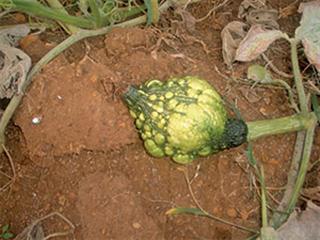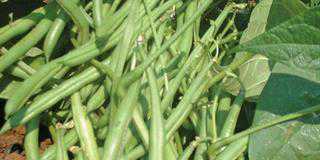
The virus is usually introduced to your land by an aphid that picked it up from an infected land. A virus can also be spread by an overwintering weed or plant on your land. A number of overwintering host weed species can be infected with cucumber mosaic virus (CMV), while various legumes, including clover, can host watermelon mosaic virus type-2 (WMV-2).
Some viruses will attack more than just the cucurbits. Spotted wilt, for example, can infect a large number of weeds, many of which are perennial, and attack many vegetable crops. It’s therefore crucial to kill off these weeds in winter or the off-season.
How aphids proliferate
In spring, thanks to renewed growth and low predator levels, aphids become active on these weeds, which are often lush just before the cucurbits are planted. Later, the aphids migrate to the crops, infecting them. The number of infected weeds present will often determine the speed at which the whole crop becomes infected. Aphids ‘probe’ various plants to determine which ones they wish to feed on. If the plant sampled doesn’t taste good to them, the aphids move on, spreading the virus.
I once saw a classic example of this in a large cabbage land, which had an irregular patch of about 10 cabbages infected with cauliflower mosaic virus in the middle of the crop. There were no aphids colonising the plants and no aphicides had been sprayed. This indicated that these cabbages had been probed by a species other than a cabbage aphid that had probed an infected cabbage on another farm.
The viruses that infect cucurbits can be transmitted to aphids minutes after the insects start feeding on an infected plant. In turn, the aphids can pass the virus on to a healthy plant in minutes. However, as aphids are only able to retain the virus for a few hours, these viruses are not usually transported over long distances. This is why it’s so important to control weeds in the immediate area.
It’s never too late
All too often, when farmers find themselves with a virus, they resign themselves to having their entire land infected. This need not be the case. If you’re vigilant, you can slow down the progress of the virus and, in some cases, even kill it off completely. Success will depend on the source of infected aphids. If it was a single weed and a chance aphid, you might have success. If, however, there is a continual arrival of infected aphids, then the chances of solving the problem are slim.
Because aphids are the chief vector, it’s important to prevent a build-up in aphid numbers. This will slow down the spread if a virus arrives on the land. The job is laborious, but worth it; the leaves of the plants have to be turned over and checked individually for the insects.
Removing plants
An even more crucial task is to scout the land frequently for any plants showing symptoms of infection. Once identified, the plants must be removed carefully and placed in clear plastic bags. Seal the bags and allow them to ‘bake’ in the sun. It is highly unlikely you will be able to remove all the infected plants in one go, as some plants will still be in the early stage of infection and not displaying symptoms yet. You will therefore have to do frequent removals.
I have been able to remove a virus from my land completely by following this method. But even if you don’t succeed in doing this, you can slow down the progress of the virus considerably by removing infected plants.
Contact Bill Kerr at [email protected]. Please state ‘Vegetable production’ in the subject line of your email.











